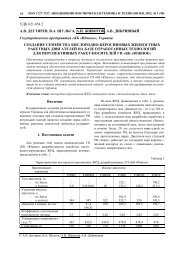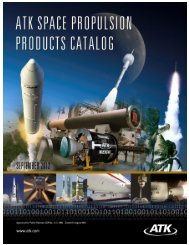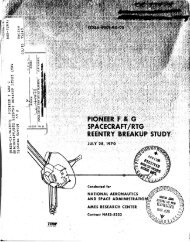6484KurtzWilliam
6484KurtzWilliam
6484KurtzWilliam
You also want an ePaper? Increase the reach of your titles
YUMPU automatically turns print PDFs into web optimized ePapers that Google loves.
43 rd Gun & Missile Conference<br />
Guided MLRS Electronic Safety & Arming<br />
Devices (ESAD) & Electronic Safety &<br />
Arming Fuze (ESAF)<br />
Presented by: Mr Perry Salyers<br />
April 2008
Agenda<br />
• Introduction<br />
• MLRS Overview<br />
• M30 Guided MLRS DPICM<br />
• Guided MLRS Unitary (6” ESAF)<br />
• M31 Guided MLRS Unitary (3” ESAF)<br />
• Conclusion<br />
2
Guided MLRS USA And Foreign Partners<br />
3
MLRS Background<br />
• MLRS family of munitions includes three rockets<br />
and four missiles with others in development<br />
• 13 feet long and 9 inches in diameter<br />
• Tube-launched, spin-stabilized, free-flight<br />
projectile<br />
• Range is a function of launcher elevation<br />
• Latest designs utilize canards to correct the<br />
trajectory during the flight and rolling fins to<br />
provide stability<br />
• Assembled, checked, and packaged in a dualpurpose<br />
launch-storage tube at the factory<br />
4
GMLRS Operation<br />
5
Evolutions in MLRS Rockets<br />
1979<br />
M26 MLRS<br />
1992<br />
M26A1 ER-MLRS<br />
2004<br />
XM31 GMLRS Unitary<br />
2001<br />
M30 GMLRS DPICM<br />
6
Evolutions in MLRS Fuzing<br />
1979<br />
M445 1992<br />
M451<br />
2004<br />
GMLRS Unitary ESAF<br />
2001<br />
GMLRS DPICM ESAD<br />
7
M30 Guided MLRS (DPICM)<br />
• Began EMD in 1999<br />
• Grew from need for increased range and accuracy<br />
– GPS aided inertial guidance package<br />
– Control actuation system<br />
– Spinning tail fins<br />
– Canards provide basic maneuverability<br />
• Maximum range 60+ km<br />
• Accuracy measured in meters<br />
• Enhanced anti-jam capabilities<br />
• Dispenses 404 M101 DPICM Submunitions<br />
• Decreases number of rockets to defeat targets by as much as<br />
80%<br />
• New Fuze – GMLRS ESAD<br />
8
The Guided MLRS DPICM Rocket Design<br />
Warhead Skin<br />
Battery<br />
Nose Cap<br />
Electronic Safe<br />
and Arming Device<br />
Guidance Section<br />
(IMU + GPS)<br />
Rocket Motor Case &<br />
Skin<br />
Center Core Burster<br />
with Grenades w/Self-Destruct Fuze<br />
Spinning Tail Fins<br />
Control Actuation System<br />
Battery<br />
CAS<br />
GS<br />
ESAD<br />
9
DPICM Round: Guidance and Control Section<br />
Umbilical<br />
ESAD<br />
Control Actuation Set<br />
GPS Antenna<br />
Guidance<br />
Set<br />
10
Guided MLRS (DPICM) ESAD<br />
• Replaced electro-mechanical fuze with In-Line<br />
Electronic Safe and Arm Device (ESAD)<br />
• Design meets MIL-STD-1316D and STANAG<br />
4187<br />
• High voltage generation needed due to<br />
removal of mechanical interrupters<br />
• Uses solid state high voltage switch (NMCT)<br />
• Safety environments – changed from setback<br />
and ram air to umbilical disconnect and<br />
acceleration<br />
• Utilizes MEMS accelerometer<br />
• First motion and safe separation verification<br />
• Sequencing and acceleration for time<br />
11
Guided MLRS (DPICM) ESAD<br />
• External Low Energy EFI (LEEFI) used<br />
– Designed in Unison by China Lake, Reynolds Systems<br />
and Silicon Designs<br />
– The LEEFI Has Been Qualified by China Lake IAW MIL-<br />
DTL-23659<br />
– Specific Tests Designed to Demonstrate the Initiator<br />
Meets a Reliability of 0.99 at a 95% Confidence Level<br />
Were Performed<br />
• Serial interface<br />
– Overhead safety timer can be programmed in launcher<br />
– Provides real time status of events<br />
12
Guided MLRS (DPICM) ESAD<br />
• Arm/fire command issued prior to desired detonation point<br />
• Fuzing Modes: Arm/Fire<br />
• Increased shelf life & reliability over mechanical system<br />
– No mechanical parts<br />
– Hermetically sealed housing<br />
• Increased testability<br />
– Can be fully tested on bench to verify proper operation<br />
• Qualified in 2002<br />
• > 2300 Delivered to date<br />
13
6 Inch Unitary ESAF Warhead Design<br />
• KDI developed and qualified a variant of the DPICM<br />
Round ESAD for use on the Unitary Warhead<br />
• Unit was developed and fielded in < 1 year<br />
ESAD<br />
Bulkhead Mounted Fuze Well<br />
14
M31 Guided MLRS Unitary<br />
• October 2003 - Lockheed Martin awarded an SDD contract<br />
for 86 unitary variant rockets; incorporates new 3” ESAF<br />
• May 2005 - First units delivered - accelerated following a US<br />
Army Urgent Need statement<br />
• Aug 2005 - Unitary variant began field testing in Iraq<br />
• Sep 2005 - First GMLRS unitary rockets fired in combat<br />
operations by 3rd Battalion, 13th Field Artillery (3-13 FA),<br />
214th Field Artillery Brigade<br />
• > 2100 Produced to date<br />
• Today, GMLRS unitary is the Army’s only surface-fired,<br />
precision, longer range indirect fire munition available to<br />
troops in contact in an urban environment<br />
• Affectionately referred to as the “70km sniper round”<br />
15
M31 Guided MLRS Unitary<br />
16
Unitary Warhead Design<br />
17
3” Fuzewell ESAF Warhead Design<br />
Fuzing Modes<br />
•PD<br />
•Delay<br />
•Proximity<br />
3 Inch Fuzewell<br />
18
GMLRS Unitary ESAF<br />
• Tri mode fuze functionality – proximity,<br />
impact, and impact with delay<br />
• Design compatibility with MIL-STD-<br />
1316E and STANAG 4187<br />
• GMLRS (DPICM) ESAD was baseline<br />
design<br />
• Added internal impact switches<br />
• Added external impact switch fire input<br />
• Added proximity sensor interface<br />
• Impact survivability<br />
– Survives high g longitudinal loads<br />
– Settable detonation delay time<br />
• Safety Environments – Umbilical<br />
disconnect and acceleration<br />
19
GMLRS Unitary ESAF<br />
• Serial Communications to set overhead<br />
safety time, detonation delay time, function<br />
mode, receive arm command and provide<br />
status during test and flight<br />
• Proximity sensor interface<br />
– Selectable HOB<br />
– High approach velocities<br />
• Fits 3” fuze well<br />
• Designed to be insensitive munitions (IM)<br />
compliant<br />
• Qualified 2006<br />
20
GMLRS Proximity Sensor Location<br />
21
3” Fuze Exploded View<br />
Electronics Assy<br />
Explosive Transfer<br />
Block Assy<br />
Booster Assy<br />
22
Conclusion<br />
• MLRS program has evolved over the last 30<br />
years<br />
– MLRS improvements have focused on upgrading<br />
launcher responsiveness and enhancing the range<br />
and precision of its munitions over the last 10+ years<br />
– Increased range – from 30km to 70km+<br />
– Improved lethality and reduced collateral damage by<br />
changing submunitions / warhead – DPICM, Unitary<br />
– Systems have adapted to evolving technology –<br />
GPS/INS, control systems, Fire Control, Fuzing<br />
improvements<br />
• Program team always focused on delivering<br />
weapon to meet war fighters needs - “one<br />
round, one kill capability”<br />
23














